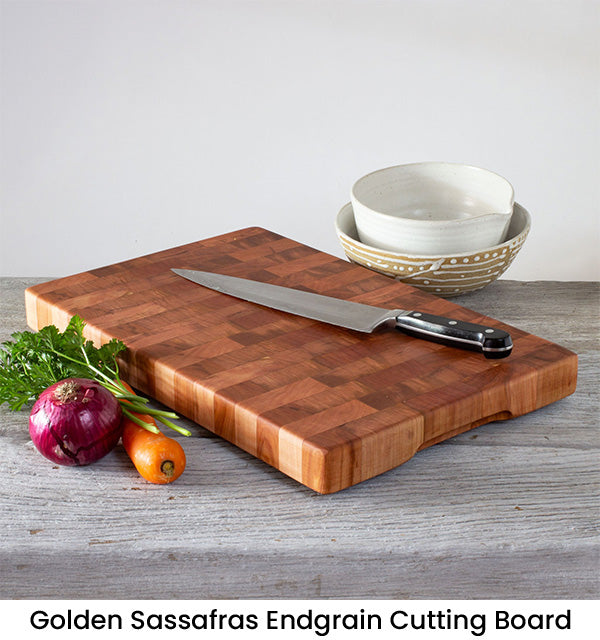Golden Sassafras: Australia's Treasured Hardwood

Golden Sassafras, native to Australia's eastern rainforests, is celebrated for its pale creamy-grey to white timber that matures into elegant grey and golden tones. This versatile hardwood is highly valued in furniture making, cabinetry, and flooring, either as solid wood or veneer. Its ease of workability and unique aesthetic appeal make it a preferred choice among artisans and designers.
Unique Appearance and Varieties
Golden Sassafras is renowned for its pale creamy grey to white timber, which develops a sophisticated grey and golden hue upon finishing. Its allure is further enhanced when the wood is affected by a staining fungus, giving rise to Blackheart Sassafras. This variant features a striking dark brown or black heartwood with green streaks, making it highly sought after for its decorative appeal. Known also as Tasmanian Sassafras or Southern Sassafras, this timber's knots and grains contribute to its unique figure, elevating the visual aesthetics of any crafted piece.
Ecological Footprint and Habitat
Predominantly found along the coastal regions of New South Wales and extending into Queensland, Golden Sassafras thrives in warm temperate and subtropical rainforests. This species is a vital component of its ecosystem, co-existing with other dominant trees such as Ceratopetalum apetalum (Coachwood) and Acmena smithii (Lilly Pilly) in the southern NSW warm-temperate rainforests. Its adaptability to a range of soil types, from enriched sandstone to volcanic loams and shales, underscores its resilience and ecological significance.
Timber Properties and Combined Uses
Golden Sassafras's timber is not just visually appealing but also possesses a range of desirable properties that make it versatile for various applications. With a density of 630 kg/m³ and a Janka hardness of 5.0, it strikes a balance between durability and workability. Its excellent finish, good machining qualities, and resistance to splitting and gluing make it a preferred choice for craftsmen and designers alike.
This timber finds its way into an array of products and projects, blending tradition with modernity. From veneers to solid timber for furniture, flooring, and cabinetry, its use is widespread. The unique properties of Golden Sassafras allow it to be easily worked into cabinet drawer sides, brushware, small tool handles, and even intricate turnery and plywood. The timber's uniform surface also serves as an excellent base for paints, stains, and varnishes, further broadening its application spectrum.
With the increasing rarity of Blackheart Sassafras, Australian Woodwork is expanding its collection to include more varieties of Sassafras timber, starting with the versatile Golden Sassafras. This move allows us to continue offering unique, high-quality woodwork items while embracing sustainability. Our Golden Sassafras Endgrain Cutting Board is the first in this new line, showcasing the timber's vibrant grain and warm, golden tones. Perfect for both culinary enthusiasts and design aficionados, this cutting board demonstrates our dedication to craftsmanship and environmental responsibility, marking the beginning of an exciting range of products crafted from the diverse Sassafras family.
Conservation Status and Environmental Adaptability
Listed as 'Least Concern' in conservation status, Golden Sassafras nonetheless faces challenges related to habitat specificity and environmental changes. Its limited availability is a reminder of the delicate balance between nature and human activity. The species shows remarkable adaptability to environmental conditions, tolerating light frosts and thriving in partial shade to full sun. However, changing climate conditions and the impact of deforestation on its natural habitat call for mindful conservation practices to ensure its sustainability for future generations.
Cultural and Economic Importance
The significance of Golden Sassafras extends beyond its ecological and aesthetic value, embedding itself into the cultural fabric and economic framework of Australia. Historically, it has played a pivotal role in woodworking and furniture making, symbolizing the rich heritage of Australian craftsmanship. Today, it continues to support the timber and woodworking industries, contributing to local economies and promoting sustainable management practices.
The ongoing use of Golden Sassafras in contemporary design and architecture reflects its enduring appeal and versatility. Efforts to preserve this treasured hardwood underscore the importance of balancing ecological conservation with economic development, ensuring that Golden Sassafras remains a sustainable resource for generations to come.
Conclusion
Golden Sassafras epitomizes the beauty, resilience, and diversity of Australia's natural resources. Its unique characteristics, from its stunning appearance to its versatile applications, make it a treasured hardwood within the country and beyond. By championing sustainable practices and recognizing their ecological, cultural, and economic significance, we can ensure that Golden Sassafras continues to thrive, contributing to Australia's rich environmental heritage and woodworking tradition.







